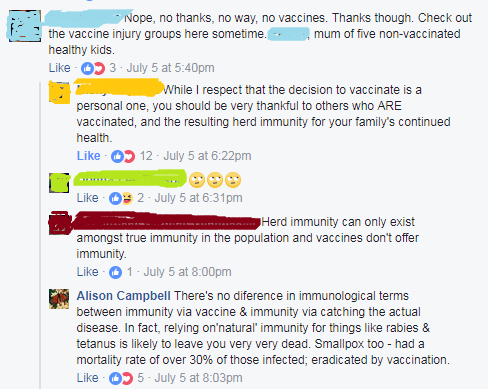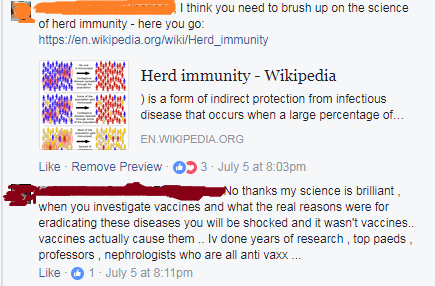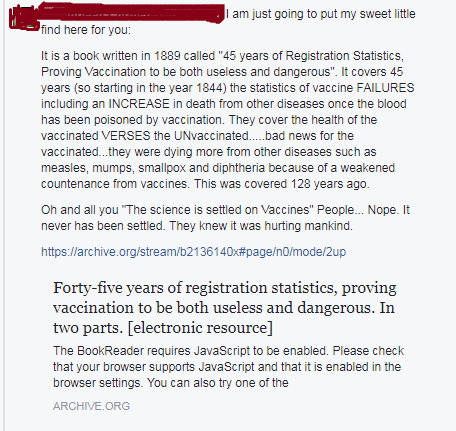I first wrote this post back in 2017 during a mumps outbreak in my local area. Now, of course, much of the media attention is focused on the ongoing tragedy that is the measles epidemic in Samoa, with 44 dead as of today and nearly 4,000 having contracted the illness so far.
The anti-vaccine activists infectious disease proponents have no shame, however, and are still popping up on every social media post about Samoa to push the line that measles is benign if you’re healthy, and that vaccines cause the disease.
One that I’ve just come across seems rather proud to have discovered a book (not much more than a pamphlet, really) written back in the late 1880s by Alfred Russel Wallace. So I thought it might be timely to edit and republish this particular post of mine. (The links have been updated where necessary.)
It’s concerning in late 2019 to hear again of outbreaks of mumps in Auckland & the Waikato, as this suggests that in some areas the number of vaccinated individuals in the population has fallen below what’s needed to maintain herd immunity: see Siouxsie Wiles’ excellent post on this. Back during a previous outbreak in 2017, one of the admins on my local suburb’s Facebook page posted information about the Waikato outbreak, with a reminder to people to check their own & their children’s immunisation status. This is because mumps isn’t a particularly benign disease, especially in older children, teens, and adults. (At this point I’ll add that the fact that in 2019 we have had both measles and mumps outbreaks makes me wonder when we’ll start seeing the impact of rubella as well.)
I suppose we could have predicted that those promoting an ‘alternative’ take on vaccinations would appear.


The ‘discussion’ was mildly entertaining, in that apparently this particular individual’s ‘brilliant’ science education via the University of Google totally trumps all of immunology – especially so when they presented this particular book as evidence that All Vaccines Are Evil. In fact, that totally cracked me up.

Why? Because this book, by Alfred Russel Wallace (yes, that Alfred Russel Wallace) was published in 1889, and was based on data on mortality drawn from the UK’s birth and death registers. Unfortunately the admin of our local FB page disabled comments before I could ask just which vaccines were being used way back then, if – as claimed – the book showed that all vaccines were baaaad.
As it happens, just three vaccines were available in the period that Wallace reviewed: smallpox (1797), cholera (1879), and rabies (1885). Given that rabies vaccine was given after exposure to the virus, the only two likely to have been in play in Wallace’s England were the vaccines for smallpox & cholera. Wallace seems to have focused on the smallpox vaccine in his book. As you’d expect, conditions for manufacturing, transporting, and using the vaccine were not exactly up to modern standards. According to this article (you’ll find the original references cited there),
Until the end of the 19th Century vaccination was done either directly with vaccine produced on the skin of calves or, particularly in England, with vaccine obtained from the calf but then maintained by arm-to-arm transfer; initially in both cases vaccine could be dried on ivory points for short term storage or transport but increasing use was made of glass capillary tubes for this purpose towards the end of the century. During this period there were no adequate methods for assessing the safety of the vaccine and there were instances of contaminated vaccine transmitting infections such as erysipelas, tetanus, septicaemia and tuberculosis. In the case of arm-to-arm transfer there was also the risk of transmitting syphilis.
Nonetheless, childhood vaccination against smallpox was made compulsory in England in 1853 – a measure of the fear with which this disease was regarded.
During the period surveyed by Wallace, he recorded a ‘slight decrease’ in smallpox mortality, and there was indeed an epidemic in the final decade of his study. However, he himself notes that the unvaccinated population would have included:
infants dying under vaccination age, … children too weakly or diseased to be vaccinated, … [and] a large but unknown number of the criminal and nomad population who escape the vaccination officers. These are often badly fed and live under the most unsanitary conditions; they are, therefore, especially liable to suffer in epidemics of Small-pox…
And given the lack of any other vaccines against measles, diphtheria, typhoid, tetanus and others, it should hardly have been a surprise to his readers (now or then) that deaths from those diseases continued unabated.
However, I should thank the person who posted that link (although I can’t, because she blocked me) – without it, I’d probably never have known about Wallace’s stance on vaccinations.

Renee says:
I normally avoid wading into the vaxx debate, because I know that the rabid-antis will never ever change their minds no matter what evidence they are presented with. But I think it’s occasionally worth it on those public notice boards as you may just reach some of the undecideds, who haven’t done their own research but are scared by the fearmongering of the antis.
Keep up the good work your Scienceness! 🙂
Alison Campbell says:
Yes, like you I doubt the ‘rabid-antis’ will change their minds; on the odd occasion when I’ve asked “what evidence would cause you to change your position on this”, I’ve been told, “nothing”. But the reason I & others keep writing about vaccines & vaccinations is that people who’ve yet to make up their minds might find it useful.